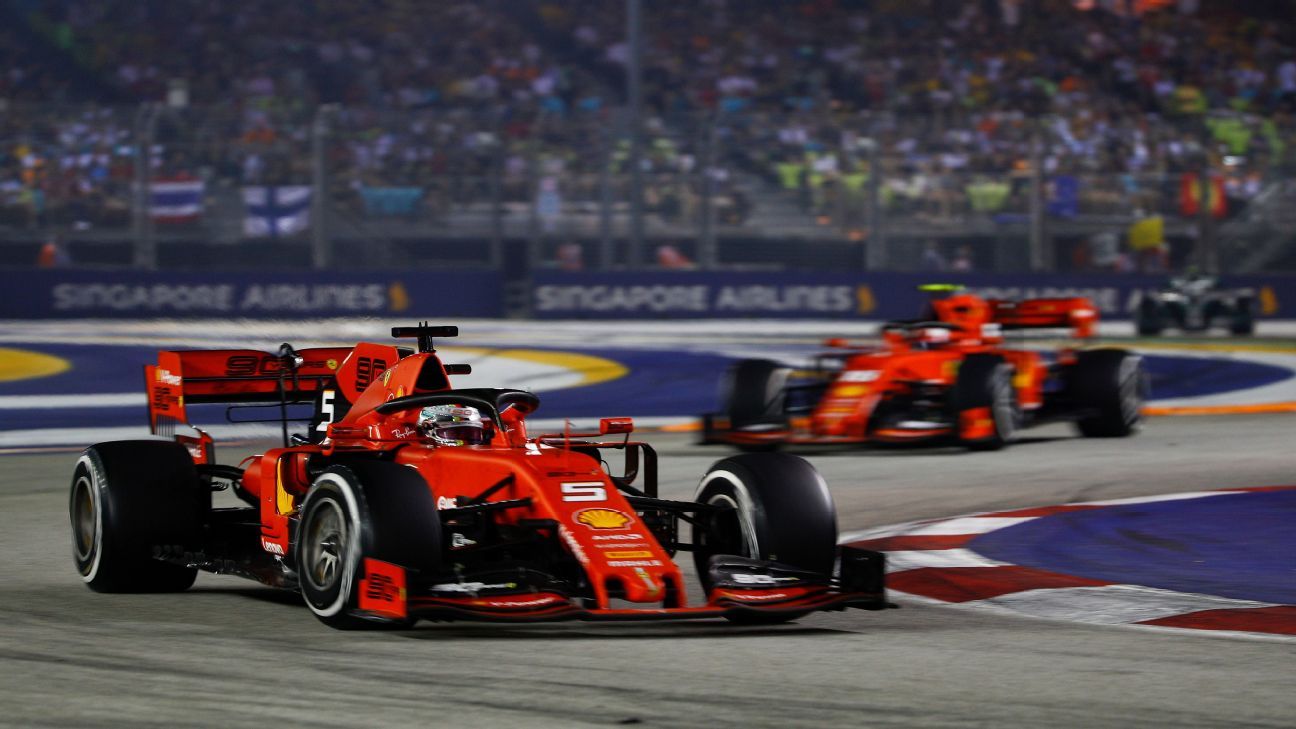SINGAPORE — Sebastian Vettel finally has something to smile about in 2019 after benefiting enormously from an undercut and leapfrogging teammate Charles Leclerc to win the Singapore Grand Prix.
Mercedes wasn’t so fortunate as its strategy backfired, leaving the team without a podium finisher for just the second time this season.
How Vettel beat Leclerc for victory
Leclerc had done everything right. He took pole position. He enjoyed a solid getaway off the line. He led into Turn 1 and he managed the pace beautifully, or so he thought.
But by slowing the pack down in the first phase of the race — Ferrari’s tactic to prevent Mercedes or Red Bull from finding a gap to stop, slot back into and gain track position from an undercut — it inadvertently opened the door for his teammate to pounce.
Vettel was the first of the top six to stop when he came in and ditched his soft tyres for the hard compound on Lap 19 — a move that turned out to be a masterstroke with the undercut working an absolute treat around Marina Bay.
Leclerc came into the pit lane on the very next lap, but it was too late. Vettel had moved himself ahead and into the net lead of the race. From there it was always going to be a challenge for Leclerc to recover, and he was clearly disappointed with how the strategy had panned out.
“We’ll talk about this one after the race,” he told his Ferrari crew. “It’s not fair.”
There was some speculation that Ferrari might switch its drivers around, but it would have taken a brave person to tell Vettel to let the 21-year-old by. Plus, the confidence Vettel would take from his first win in over 12 months was just too much to pass up.
Leclerc harassed Vettel to the chequered flag but was unable to find a way through, in the end settling for second as Ferrari claimed its first one-two finish since 2017.
After the race, Leclerc took the high ground and opted not to slam his team.
“I didn’t expect Seb to pass me, but I also completely understand that if this decision has been taken it’s for the good of the team,” he said. “But it’s hard to understand in the car.”
Ferrari team boss Mattia Binotto said his team was backed into a corner in terms of strategy for the No. 5 car.
“When we stopped Sebastian, Verstappen was ready to stop, so we had to protect his position,” Binotto said. “It was the best opportunity for us to overtake Hamilton. So that was the right time to stop Sebastian.
“We could not have stopped Charles at that stage. If you’re leading the race you cannot stop [from] first.”
Did Ferrari favour Vettel?
Leclerc’s frustration was clear to hear on the radio during the race and still visible as he fidgeted through his post-race press conference. A shot at a hat-trick of victories had slipped through his fingers, and it had happened through no fault of his own.
The key had been the above-mentioned undercut and just how powerful it proved to be as a strategic tactic. Both Ferrari and Mercedes admitted after the race that they had not expected Vettel to gain such a pace advantage from switching to hard tyres earlier than the two cars in front and had not anticipated it would give him the lead.
“The undercut was effectively more powerful than expected — it was 3.9 seconds and we were not expecting such a big number,” Binotto said. “As a matter of fact, when we stopped Sebastian, we thought when Charles stopped the lap after, he would come out ahead of Sebastian. Sebastian drove well, got the undercut of 3.9 seconds, that’s the difference.”
All well and good, but in normal circumstances a team’s leading car would be given the preferable strategy and the advantage of an undercut. The thing is, this wasn’t normal circumstances. Leclerc had been slowing the pack on purpose to try to prevent a rival attempting an undercut of their own, but that strategy could only last so long. On lap 19 Red Bull took a brave pill and got ready to pit Max Verstappen, who was running fourth, despite the fact it would drop him into trouble. That immediately put Vettel’s third place at risk and the team made the call for him to come in on the same lap just two corners from the pit entrance.
The other thing to consider is that pitting Leclerc on lap 19 would have unbottled Hamilton’s pace. It wasn’t clear how much faster Hamilton could go, but the car looked quick and there was no way Vettel would get past the Mercedes if Leclerc triggered the pit stops first and he had to stay out another lap.
Asked if Ferrari broke convention by pitting its lead car a lap later than the one behind, Binotto added: “Not really, we have always given the advantage to the car ahead — that’s normally the rules we are doing — but in that case, you would not stop Charles as first he was leading the race, he would have been in traffic, and that would have been the wrong move.
“The opposite in fact, Verstappen was ready to stop — we knew that — and the best way to protect Sebastian’s position was to stop him, and make sure the pit was free on the next laps for Charles’ pit stop. It was the right timing to stop Seb — on that there are no dicussions. The following lap it was the right timing to stop Charles and we are happy with that because if it is a one-two or two-one, it is still a Ferrari one-two.”
The only question that remained was why Ferrari failed to tell Leclerc that Vettel had pitted. Armed with that information, perhaps Leclerc could have upped his pace on his in-lap and made up the very small 0.4s difference he needed to remain ahead of his teammate after his pit stop. Leclerc mentioned the lack of communication to the media when he got out of the car but, oddly, Binotto was not aware of the missing radio message when he talked to the media just before midnight and after the team’s own internal briefing.
“I thought we told you?” he said, turning to Leclerc who shook his head. “No? Maybe not?
“I think honestly we were at that stage, including for us, we knew that the next lap it would have been. I think we were concentrating on making sure everything was right, and I think the team was first, there was the positions one-two.
“I think it was not at that stage, we were fighting to gain the position for Vettel.”
And on whether Ferrari was considering swapping the drivers back with a team order to hand the win back to Leclerc, Binotto said it was discussed on the pit wall but ultimately ruled out.
“I understand Charles is, somehow, a bit disappointed because he was trying to do his best to win the race, and I think he did whatever he could to win the race,” Binotto added. “Did we consider the swap? Yes, we did.
“But I think we thought at that stage at least it was the right choice not to do it, and obviously now, we are still discussing with the drivers if that was the right choice or not, which internally we still have different opinions to discuss. But yes, we thought about it.”
Mercedes’ Hamilton gamble fails to pay dividends
When you hold a commanding lead in both championships, you can afford to make a bold strategy call from time to time.
With Vettel having already pitted and Leclerc driving into the lane on the following lap, Lewis Hamilton, who was running second, was either going to follow the Ferrari into the pits and remain behind or stay out and extend his first stint in order to give himself a chance of chasing them down on fresher rubber in the closing stages.
He stayed out.
By the time Mercedes brought him in on Lap 26, Max Verstappen had stolen third place, but that was always going to be the price Mercedes had to pay in order to have more grip than its rivals when it mattered most. Unfortunately for them, the gamble failed to pay off.
Hamilton’s hard tyres may have been seven laps younger than Vettel’s, and six younger than Leclerc’s, but he could not find a way through and was forced to settle for fourth place — the first time he has missed the podium in Singapore since 2015.
Despite the disappointment, Hamilton managed to extend his championship lead to a season-high 65 points.
Danny Ric puts on a show … for half the race
Daniel Ricciardo called it early on in the grand prix.
“We’re not f—ing around tonight,” he declared on Lap 7 at Marina Bay. “Let’s go boys!”
The Australian had qualified eighth fastest in Singapore, but was later disqualified from the session and demoted to the rear of the field due to a power infringement on his Renault. However, any thoughts of a boring evening under the lights were put to bed early with Ricciardo making a blistering start to jump four places in half a lap.
He continued picking off cars, making his way into the top 10 by the time the pit window opened, but instead of stopping for fresh tyres he stayed out and at one stage found himself in the top three.
Unfortunately for Ricciardo, just when it appeared he might be salvaging something he made contact with Antonio Giovinazzi and sustained a puncture, dropping him back through the field. He eventually finished 14th, but was still visibly livid about being disqualified from qualifying when he returned to the paddock.
“If every lap I’m getting a micro second gain, then I’d understand. OK, eliminate me from the session,” Ricciardo said. “But it happened on one occurrence, for one milli-second, on one lap. And the lap did not affect my qualifying.
“I have some strong words for [the stewards], but I’ll leave that. I think you know what I feel. They ruined my weekend. A 12-hour flight, I feel was for nothing. So maybe they will pay for my seat on the way home tomorrow.”
However, race director Michael Masi didn’t agree with Ricciardo’s take on the matter.
“When it comes to technical infringements, I think Martin Brundle put it best when I bumped into him down on the grid, he said: ‘You’re either pregnant or you’re not’. Those were his words, but it’s one of those that when it comes down to a technical infringement of that nature the outcome is that you either are [breaking the rules] or you aren’t. While I can feel for Daniel, it was an error and, sadly, it is what it is.
“We would be steeping in dangerous territory, with technical infringements in particular, if we start building margins in upon margins, upon margins. There was a margin there and the margin was exceeded — the margin that applies to everyone.”
Bottas forever the wingman?
Before the race had even hit half distance, Mercedes’ chief strategist James Vowles was on the radio telling Valtteri Bottas to slow down. That’s right, once again Bottas was playing helper to Hamilton.
As mentioned above, the Ferraris had executed the undercut and the only way Mercedes were ever going to have a chance of winning the race was by running Hamilton long in the first stint to ensure fresher tyres at the end of the grand prix.
But instead of pitting him on lap 23 when there was a sufficient gap to slot back into, the team told Bottas to ease up — given the clear benefit of the undercut — in order for Hamilton to bang in two further laps, comfortably rejoin in fourth place and ensure his hard tyres were a further two laps younger than Vettel and Leclerc’s out front.
Had Bottas continued lapping as quick as possible, Hamilton would likely have emerged from his first stop behind him, as well as Red Bull’s Alex Albon. But Bottas obliged and added close to three seconds to his following lap, confirming his status as the clear No. 2 driver at Mercedes.
Again, the gamble didn’t pay off for the Silver Arrows and Hamilton finished fourth with Bottas coming home in fifth.
Safety Car, Safety Car, Safety Car
There has been at least one Safety Car intervention at every single Singapore Grand Prix, and that streak continued on Sunday with no fewer than three incidents requiring the pace car to take control of the field.
The Safety Car first came out on lap 35 after Romain Grosjean and George Russell tangled on the exit of Turn 8. The contact put Russell into the barriers, ending Williams’ ‘perfect’ season of having both cars take the chequered flag at every grand prix, leaving the Brit far from impressed.
“I shouldn’t be surprised,” Russell said of Grosjean, who two days earlier received a contract extension at Haas. After the race both drivers were spotted exchanging words in the paddock.
The second Safety Car emerged on lap 43 as Sergio Perez suffered a mechanical issue in his Racing Point and parked up unsafely on track. The final Safety Car intervention came on lap 50 following a collision between Kimi Raikkonen and Daniil Kvyat at Turn 1.
Kvyat was looking to make a bold move down the inside of the 2007 world champion, but got it all wrong and the two came together as Raikkonen turned in to take the corner. Kvyat was able to continue and finished the race in P15, but Raikkonen wasn’t so lucky and had to retire. The stewards ruled the contact a racing incident.
Other points worthy of mention:
-
Lando Norris claimed an impressive P7, or best of the rest, for McLaren. The Brit held off Pierre Gasly and Nico Hulkenberg.
-
Antonio Giovinazzi enjoyed a great evening in Singapore and even overcame a 10-second post-race time penalty to finish 10th. The Italian was deemed to have driven too close to marshals during a Safety Car period. Fortunately for Giovinazzi, eleventh-placed Romain Grosjean was 17 seconds behind at the chequered flag and he was able to retain P10.
-
Despite three Safety Car periods, we still managed to get the full 61 laps in with Vettel’s winning time being 1:58:33.667.


